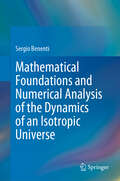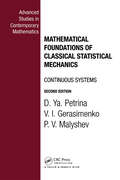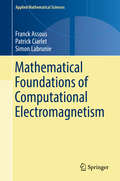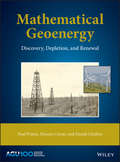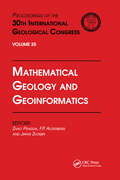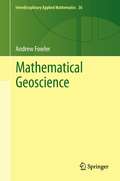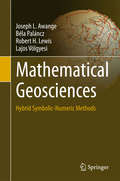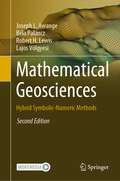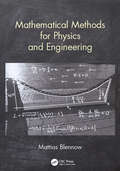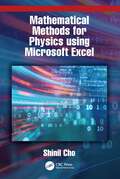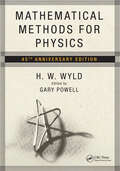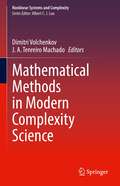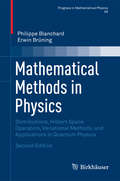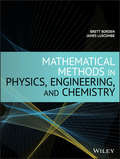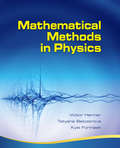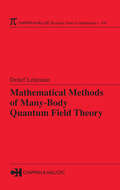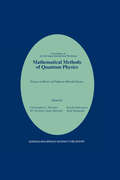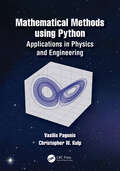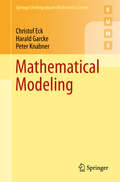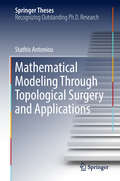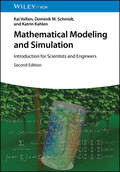- Table View
- List View
Mathematical Foundations and Numerical Analysis of the Dynamics of an Isotropic Universe
by Sergio BenentiThis book is an enhanced and expanded English edition of the treatise “Fondamenti matematici e analisi numerica della dinamica di un Universo isotropo,” published by the Accademia delle Scienze di Torino in volume no. 42-43, 2018-2019. The book summarizes some of the principal findings from a long-term cosmology research project, aiming to clarify significant results through clear mathematical postulates. Despite efforts, a single mathematical model accurately describing the universe’s evolution remains elusive due to early universe complexity and numerous observational parameters. Over the past century, various models have been proposed and discarded, illustrated by debates on the cosmological constant and spatial curvature assumptions. Currently, many models lack clear foundations, causing confusion in the field. Standard cosmological approaches rely on principles like Weyl’s principle, homogeneity, and isotropy, but may overlook discerning purely geometrical properties from those dependent on field equations. This book aims to bring order to cosmology by starting from understandable mathematical postulates, leading to theorems. Disagreements on postulates can prompt adjustments or alternative approaches. Physics often consists of deductive theories lacking explicit delineation of underlying concepts and postulates, a criticism relevant to cosmological theories. Despite a late 1990s consensus on the Lambda cold dark matter model, the absence of a logical-deductive structure in literature complicates understanding, leading some to humorously dub it the “expanding Universe and expanding confusion.”
Mathematical Foundations of Classical Statistical Mechanics
by D.Ya. Petrina V.I. Gerasimenko P V MalyshevThis monograph considers systems of infinite number of particles, in particular the justification of the procedure of thermodynamic limit transition. The authors discuss the equilibrium and non-equilibrium states of infinite classical statistical systems. Those states are defined in terms of stationary and nonstationary solutions to the Bogolyubov
Mathematical Foundations of Computational Electromagnetism (Applied Mathematical Sciences #198)
by Franck Assous Patrick Ciarlet Simon LabrunieThis book presents an in-depth treatment of various mathematical aspects of electromagnetism and Maxwell's equations: from modeling issues to well-posedness results and the coupled models of plasma physics (Vlasov-Maxwell and Vlasov-Poisson systems) and magnetohydrodynamics (MHD). These equations and boundary conditions are discussed, including a brief review of absorbing boundary conditions. The focus then moves to well‐posedness results. The relevant function spaces are introduced, with an emphasis on boundary and topological conditions. General variational frameworks are defined for static and quasi-static problems, time-harmonic problems (including fixed frequency or Helmholtz-like problems and unknown frequency or eigenvalue problems), and time-dependent problems, with or without constraints. They are then applied to prove the well-posedness of Maxwell’s equations and their simplified models, in the various settings described above. The book is completed with a discussion of dimensionally reduced models in prismatic and axisymmetric geometries, and a survey of existence and uniqueness results for the Vlasov-Poisson, Vlasov-Maxwell and MHD equations. The book addresses mainly researchers in applied mathematics who work on Maxwell’s equations. However, it can be used for master or doctorate-level courses on mathematical electromagnetism as it requires only a bachelor-level knowledge of analysis.
Mathematical Geoenergy: Discovery, Depletion, and Renewal (Geophysical Monograph Series #241)
by Paul Pukite Dennis Coyne Daniel ChallouA rigorous mathematical problem-solving framework for analyzing the Earth’s energy resources GeoEnergy encompasses the range of energy technologies and sources that interact with the geological subsurface. Fossil fuel availability studies have historically lacked concise modeling, tending instead toward heuristics and overly-complex processes. Mathematical GeoEnergy: Oil Discovery, Depletion and Renewal details leading-edge research based on a mathematically-oriented approach to geoenergy analysis. Volume highlights include: Applies a formal mathematical framework to oil discovery, depletion, and analysis Employs first-order applied physics modeling, decreasing computational resource requirements Illustrates model interpolation and extrapolation to fill out missing or indeterminate data Covers both stochastic and deterministic mathematical processes for historical analysis and prediction Emphasizes the importance of up-to-date data, accessed through the companion website Demonstrates the advantages of mathematical modeling over conventional heuristic and empirical approaches Accurately analyzes the past and predicts the future of geoenergy depletion and renewal using models derived from observed production data Intuitive mathematical models and readily available algorithms make Mathematical GeoEnergy: Oil Discovery, Depletion and Renewal an insightful and invaluable resource for scientists and engineers using robust statistical and analytical tools applicable to oil discovery, reservoir sizing, dispersion, production models, reserve growth, and more.
Mathematical Geology and Geoinformatics: Proceedings of the 30th International Geological Congress, Volume 25
by Zhao Pengda F. P. Agterberg Jiang ZuoqinThis book presents the proceedings of the 30th International Geological Congress, providing information on geological hazards map and image analytical systems, mineral resources with integrated information, phase-separation analysis, mineral reserve estimation, and geosciences and management information systems.
Mathematical Geoscience
by Andrew FowlerMathematical Geoscience is an expository textbook which aims to provide a comprehensive overview of a number of different subjects within the Earth and environmental sciences. Uniquely, it treats its subjects from the perspective of mathematical modelling with a level of sophistication that is appropriate to their proper investigation. The material ranges from the introductory level, where it can be used in undergraduate or graduate courses, to research questions of current interest. The chapters end with notes and references, which provide an entry point into the literature, as well as allowing discursive pointers to further research avenues. The introductory chapter provides a condensed synopsis of applied mathematical techniques of analysis, as used in modern applied mathematical modelling. There follows a succession of chapters on climate, ocean and atmosphere dynamics, rivers, dunes, landscape formation, groundwater flow, mantle convection, magma transport, glaciers and ice sheets, and sub-glacial floods. This book introduces a whole range of important geoscientific topics in one single volume and serves as an entry point for a rapidly expanding area of genuine interdisciplinary research. By addressing the interplay between mathematics and the real world, this book will appeal to graduate students, lecturers and researchers in the fields of applied mathematics, the environmental sciences and engineering.
Mathematical Geosciences
by Joseph L. Awange Béla Paláncz Robert H. Lewis Lajos VölgyesiThis book showcases powerful new hybrid methods that combine numerical and symbolic algorithms. Hybrid algorithm research is currently one of the most promising directions in the context of geosciences mathematics and computer mathematics in general. One important topic addressed here with a broad range of applications is the solution of multivariate polynomial systems by means of resultants and Groebner bases. But that’s barely the beginning, as the authors proceed to discuss genetic algorithms, integer programming, symbolic regression, parallel computing, and many other topics.The book is strictly goal-oriented, focusing on the solution of fundamental problems in the geosciences, such as positioning and point cloud problems. As such, at no point does it discuss purely theoretical mathematics. "The book delivers hybrid symbolic-numeric solutions, which are a large and growing area at the boundary of mathematics and computer science." Dr. Daniel Lichtbau
Mathematical Geosciences: Hybrid Symbolic-Numeric Methods
by Joseph L. Awange Béla Paláncz Robert H. Lewis Lajos VölgyesiThis second edition of Mathematical Geosciences book adds five new topics: Solution equations with uncertainty, which proposes two novel methods for solving nonlinear geodetic equations as stochastic variables when the parameters of these equations have uncertainty characterized by probability distribution. The first method, an algebraic technique, partly employs symbolic computations and is applicable to polynomial systems having different uncertainty distributions of the parameters. The second method, a numerical technique, uses stochastic differential equation in Ito form; Nature Inspired Global Optimization where Meta-heuristic algorithms are based on natural phenomenon such as Particle Swarm Optimization. This approach simulates, e.g., schools of fish or flocks of birds, and is extended through discussion of geodetic applications. Black Hole Algorithm, which is based on the black hole phenomena is added and a new variant of the algorithm code is introduced and illustrated based on examples; The application of the Gröbner Basis to integer programming based on numeric symbolic computation is introduced and illustrated by solving some standard problems; An extension of the applications of integer programming solving phase ambiguity in Global Navigation Satellite Systems (GNSSs) is considered as a global quadratic mixed integer programming task, which can be transformed into a pure integer problem with a given digit of accuracy. Three alternative algorithms are suggested, two of which are based on local and global linearization via McCormic Envelopes; and Machine learning techniques (MLT) that offer effective tools for stochastic process modelling. The Stochastic Modelling section is extended by the stochastic modelling via MLT and their effectiveness is compared with that of the modelling via stochastic differential equations (SDE). Mixing MLT with SDE also known as frequently Neural Differential Equations is also introduced and illustrated by an image classification via a regression problem.
Mathematical Methods for Oscillations and Waves
by Joel FranklinAnchored in simple and familiar physics problems, the author provides a focused introduction to mathematical methods in a narrative driven and structured manner. Ordinary and partial differential equation solving, linear algebra, vector calculus, complex variables and numerical methods are all introduced and bear relevance to a wide range of physical problems. Expanded and novel applications of these methods highlight their utility in less familiar areas, and advertise those areas that will become more important as students continue. This highlights both the utility of each method in progressing with problems of increasing complexity while also allowing students to see how a simplified problem becomes 're-complexified'. Advanced topics include nonlinear partial differential equations, and relativistic and quantum mechanical variants of problems like the harmonic oscillator. Physics, mathematics and engineering students will find 300 problems treated in a sophisticated manner. The insights emerging from Franklin's treatment make it a valuable teaching resource.
Mathematical Methods for Physics and Engineering
by M. P. Hobson K. F. Riley S. J. BenceMathematical Methods for Physics and Engineering, Third Edition is a highly acclaimed undergraduate textbook that teaches all the mathematics for an undergraduate course in any of the physical sciences. As well as lucid descriptions of all the topics and many worked examples, it contains over 800 exercises. New stand-alone chapters give a systematic account of the 'special functions' of physical science, cover an extended range of practical applications of complex variables, and give an introduction to quantum operators. This solutions manual accompanies the third edition of Mathematical Methods for Physics and Engineering. It contains complete worked solutions to over 400 exercises in the main textbook, the odd-numbered exercises, that are provided with hints and answers. The even-numbered exercises have no hints, answers or worked solutions and are intended for unaided homework problems; full solutions are available to instructors on a password-protected web site, www. cambridge. org/9780521679718.
Mathematical Methods for Physics and Engineering
by Mattias BlennowSuitable for advanced undergraduate and graduate students, this new textbook contains an introduction to the mathematical concepts used in physics and engineering. <p><p>The entire book is unique in that it draws upon applications from physics, rather than mathematical examples, to ensure students are fully equipped with the tools they need. This approach prepares the reader for advanced topics, such as quantum mechanics and general relativity, while offering examples, problems, and insights into classical physics. <p><p>The book is also distinctive in the coverage it devotes to modelling, and to oft-neglected topics such as Green's functions.
Mathematical Methods for Physics using Microsoft EXCEL
by Shinil ChoIn Mathematical Methods for Physics using Microsoft Excel, readers will investigate topics from classical to quantum mechanics, which are often omitted from the course work. Some of these topics include rocket propulsion, Rutherford scattering, precession and nutation of a top under gravity, parametric oscillation, relativistic Doppler effect, concepts of entropy, kinematics of wave packets, and boundary value problems and associated special functions as orthonormal bases. Recent topics such as the Lagrange point of the James Webb Space Telescope, a muon detector in relation to Cherenkov’s radiation, and information entropy and H-function are also discussed and analyzed. Additional interdisciplinary topics, such as self-avoiding random walks for polymer length and population dynamics, are also described.This book will allow readers to reproduce and replicate the data and experiments often found in physics textbooks, with a stronger foundation of knowledge. While investigating these subjects, readers will follow a step-by-step introduction to computational algorithms for solving differential equations for which analytical solutions are often challenging to find. For computational analysis, features of Microsoft Excel® including AutoFill, Iterative Calculation, and Visual Basic for Applications are useful to conduct hands-on projects. For the visualization of computed outcomes, the Chart output feature can be readily used. There are several first-time attempts on various topics introduced in this book such as 3D-like graphics using Euler’s angle and the behavior of wave functions of harmonic oscillators and hydrogen atoms near the true eigenvalues.
Mathematical Methods for Physics: 45th anniversary edition
by H.W. Wyld Gary PowellFrom classical mechanics and classical electrodynamics to modern quantum mechanics many physical phenomena are formulated in terms of similar partial differential equations while boundary conditions determine the specifics of the problem. This 45th anniversary edition of the advanced book classic Mathematical Methods for Physics demonstrates how many physics problems resolve into similar inhomogeneous partial differential equations and the mathematical techniques for solving them. The text has three parts: Part I establishes solving the homogenous Laplace and Helmholtz equations in the three main coordinate systems, rectilinear, cylindrical, and spherical and develops the solution space for series solutions to the Sturm-Liouville equation, indicial relations, and the expansion of orthogonal functions including spherical harmonics and Fourier series, Bessel, and Spherical Bessel functions. Many examples with figures are provided including electrostatics, wave guides and resonant cavities, vibrations of membranes, heat flow, potential flow in fluids, and plane and spherical waves. In Part II the inhomogeneous equations are addressed where source terms are included for Poisson's equation, the wave equation, and the diffusion equation. Coverage includes many examples from averaging approaches for electrostatics and magnetostatics, from Green function solutions for time independent and time dependent problems, and from integral equation methods. In Part III complex variable techniques are presented for solving integral equations involving Cauchy Residue theory, contour methods, analytic continuation, and transforming the contour; for addressing dispersion relations; for revisiting special functions in the complex plane; and for transforms in the complex plane including Green’s functions and Laplace transforms.Key Features: Mathematical Methods for Physics creates a strong, solid anchor of learning and is useful for reference Lecture note style suitable for advanced undergraduate and graduate students to learn many techniques for solving partial differential equations with boundary conditions Many examples across various subjects of physics in classical mechanics, classical electrodynamics, and quantum mechanics Updated typesetting and layout for improved clarity This book, in lecture note style with updated layout and typesetting, is suitable for advanced undergraduate, graduate students, and as a reference for researchers. It has been edited and carefully updated by Gary Powell.
Mathematical Methods for Physics: An Introduction to Group Theory, Topology and Geometry
by Esko Keski-Vakkuri Claus Montonen Marco PaneroThis detailed yet accessible text provides an essential introduction to the advanced mathematical methods at the core of theoretical physics. The book steadily develops the key concepts required for an understanding of symmetry principles and topological structures, such as group theory, differentiable manifolds, Riemannian geometry, and Lie algebras. Based on a course for senior undergraduate students of physics, it is written in a clear, pedagogical style and would also be valuable to students in other areas of science and engineering. The material has been subject to more than twenty years of feedback from students, ensuring that explanations and examples are lucid and considered, and numerous worked examples and exercises reinforce key concepts and further strengthen readers' understanding. This text unites a wide variety of important topics that are often scattered across different books, and provides a solid platform for more specialized study or research.
Mathematical Methods in Modern Complexity Science (Nonlinear Systems and Complexity #33)
by Dimitri Volchenkov J. A. Tenreiro MachadoThis book presents recent developments in nonlinear and complex systems. It provides recent theoretic developments and new techniques based on a nonlinear dynamical systems approach that can be used to model and understand complex behavior in nonlinear dynamical systems. It covers information theory, relativistic chaotic dynamics, data analysis, relativistic chaotic dynamics, solvability issues in integro-differential equations, and inverse problems for parabolic differential equations, synchronization and chaotic transient. Presents new concepts for understanding and modeling complex systems
Mathematical Methods in Physics
by Philippe Blanchard Erwin BrüningThe second edition of this textbook presents the basic mathematical knowledge and skills that are needed for courses on modern theoretical physics, such as those on quantum mechanics, classical and quantum field theory, and related areas. The authors stress that learning mathematical physics is not a passive process and include numerous detailed proofs, examples, and over 200 exercises, as well as hints linking mathematical concepts and results to the relevant physical concepts and theories. All of the material from the first edition has been updated, and five new chapters have been added on such topics as distributions, Hilbert space operators, and variational methods. The text is divided into three parts: - Part I: A brief introduction to (Schwartz) distribution theory. Elements from the theories of ultra distributions and (Fourier) hyperfunctions are given in addition to some deeper results for Schwartz distributions, thus providing a rather comprehensive introduction to the theory of generalized functions. Basic properties and methods for distributions are developed with applications to constant coefficient ODEs and PDEs. The relation between distributions and holomorphic functions is considered, as well as basic properties of Sobolev spaces. - Part II: Fundamental facts about Hilbert spaces. The basic theory of linear (bounded and unbounded) operators in Hilbert spaces and special classes of linear operators - compact, Hilbert-Schmidt, trace class, and Schrödinger operators, as needed in quantum physics and quantum information theory - are explored. This section also contains a detailed spectral analysis of all major classes of linear operators, including completeness of generalized eigenfunctions, as well as of (completely) positive mappings, in particular quantum operations. - Part III: Direct methods of the calculus of variations and their applications to boundary- and eigenvalue-problems for linear and nonlinear partial differential operators. The authors conclude with a discussion of the Hohenberg-Kohn variational principle. The appendices contain proofs of more general and deeper results, including completions, basic facts about metrizable Hausdorff locally convex topological vector spaces, Baire's fundamental results and their main consequences, and bilinear functionals. Mathematical Methods in Physics is aimed at a broad community of graduate students in mathematics, mathematical physics, quantum information theory, physics and engineering, as well as researchers in these disciplines. Expanded content and relevant updates will make this new edition a valuable resource for those working in these disciplines.
Mathematical Methods in Physics, Engineering, and Chemistry
by James Luscombe Brett BordenA concise and up-to-date introduction to mathematical methods for students in the physical sciences Mathematical Methods in Physics, Engineering and Chemistry offers an introduction to the most important methods of theoretical physics. Written by two physics professors with years of experience, the text puts the focus on the essential math topics that the majority of physical science students require in the course of their studies. This concise text also contains worked examples that clearly illustrate the mathematical concepts presented and shows how they apply to physical problems. This targeted text covers a range of topics including linear algebra, partial differential equations, power series, Sturm-Liouville theory, Fourier series, special functions, complex analysis, the Green’s function method, integral equations, and tensor analysis. This important text: Provides a streamlined approach to the subject by putting the focus on the mathematical topics that physical science students really need Offers a text that is different from the often-found definition-theorem-proof scheme Includes more than 150 worked examples that help with an understanding of the problems presented Presents a guide with more than 200 exercises with different degrees of difficulty Written for advanced undergraduate and graduate students of physics, materials science, and engineering, Mathematical Methods in Physics, Engineering and Chemistry includes the essential methods of theoretical physics. The text is streamlined to provide only the most important mathematical concepts that apply to physical problems.
Mathematical Methods in Physics: Partial Differential Equations, Fourier Series, and Special Functions
by Victor Henner Tatyana Belozerova Kyle ForinashThis book is a text on partial differential equations (PDEs) of mathematical physics and boundary value problems, trigonometric Fourier series, and special functions. This is the core content of many courses in the fields of engineering, physics, mathematics, and applied mathematics. The accompanying software provides a laboratory environment that
Mathematical Methods in the Earth and Environmental Sciences
by Adrian BurdThe Earth and environmental sciences are becoming progressively more quantitative due to the increased use of mathematical models and new data analysis techniques. This accessible introduction presents an overview of the mathematical methods essential for understanding Earth processes, providing an invaluable resource for students and early career researchers who may have missed (or forgotten) the mathematics they need to succeed as scientists. Topics build gently from basic methods such as calculus to more advanced techniques including linear algebra and differential equations. The practical applications of the mathematical methods to a variety of topics are discussed, ranging from atmospheric science and oceanography to biogeochemistry and geophysics. Including over 530 exercises and end-of-chapter problems, as well as additional computer codes in Python and MATLAB®, this book supports readers in applying appropriate analytical or computational methods to solving real research questions.
Mathematical Methods of Many-Body Quantum Field Theory (Chapman & Hall/CRC Research Notes in Mathematics Series)
by Detlef LehmannMathematical Methods of Many-Body Quantum Field Theory offers a comprehensive, mathematically rigorous treatment of many-body physics. It develops the mathematical tools for describing quantum many-body systems and applies them to the many-electron system. These tools include the formalism of second quantization, field theoretical perturbation theo
Mathematical Methods of Quantum Physics: Essays in Honor of Professor Hiroshi Ezawa
by Christopher C. BernidoArticles are presented, covering a wide range of topics in the mathematical methods of quantum physics. These include infinite dimensional analysis based on white noise, operator algebra methods, Feynman path integrals, quantum mechanics on non-simply connected spaces, recent results in supersymmetric theories, stochastic and quantum dynamics, Yang-Baxter systems, statistical physics, thermo field dynamics, and quantum field theory. The essays are based on lectures contributed for the Second Jagna International Workshop held in honour of Prof. Hiroshi Ezawa, a distinguished physicist, educator, and former president of the Physical Society of Japan.
Mathematical Methods using Python: Applications in Physics and Engineering
by Vasilis Pagonis Christopher Wayne KulpThis advanced undergraduate textbook presents a new approach to teaching mathematical methods for scientists and engineers. It provides a practical, pedagogical introduction to utilizing Python in Mathematical and Computational Methods courses. Both analytical and computational examples are integrated from its start. Each chapter concludes with a set of problems designed to help students hone their skills in mathematical techniques, computer programming, and numerical analysis. The book places less emphasis on mathematical proofs, and more emphasis on how to use computers for both symbolic and numerical calculations. It contains 182 extensively documented coding examples, based on topics that students will encounter in their advanced courses in Mechanics, Electronics, Optics, Electromagnetism, Quantum Mechanics etc.An introductory chapter gives students a crash course in Python programming and the most often used libraries (SymPy, NumPy, SciPy, Matplotlib). This is followed by chapters dedicated to differentiation, integration, vectors and multiple integration techniques. The next group of chapters covers complex numbers, matrices, vector analysis and vector spaces. Extensive chapters cover ordinary and partial differential equations, followed by chapters on nonlinear systems and on the analysis of experimental data using linear and nonlinear regression techniques, Fourier transforms, binomial and Gaussian distributions. The book is accompanied by a dedicated GitHub website, which contains all codes from the book in the form of ready to run Jupyter notebooks. A detailed solutions manual is also available for instructors using the textbook in their courses.Key Features:· A unique teaching approach which merges mathematical methods and the Python programming skills which physicists and engineering students need in their courses.· Uses examples and models from physical and engineering systems, to motivate the mathematics being taught.· Students learn to solve scientific problems in three different ways: traditional pen-and-paper methods, using scientific numerical techniques with NumPy and SciPy, and using Symbolic Python (SymPy).Vasilis Pagonis is Professor of Physics Emeritus at McDaniel College, Maryland, USA. His research area is applications of thermally and optically stimulated luminescence. He taught courses in mathematical physics, classical and quantum mechanics, analog and digital electronics and numerous general science courses. Dr. Pagonis’ resume lists more than 200 peer-reviewed publications in international journals. He is currently associate editor of the journal Radiation Measurements. He is co-author with Christopher Kulp of the undergraduate textbook “Classical Mechanics: a computational approach, with examples in Python and Mathematica” (CRC Press, 2020). He has also co-authored four graduate-level textbooks in the field of luminescence dosimetry, and most recently published the book “Luminescence Signal analysis using Python” (Springer, 2022).Christopher Kulp is the John P. Graham Teaching Professor of Physics at Lycoming College. He has been teaching undergraduate physics at all levels for 20 years. Dr. Kulp’s research focuses on modelling complex systems, time series analysis, and machine learning. He has published 30 peer-reviewed papers in international journals, many of which include student co-authors. He is also co-author of the undergraduate textbook “Classical Mechanics: a computational approach, with examples in Python and Mathematica” (CRC Press, 2020).
Mathematical Modeling
by Peter Knabner Christof Eck Harald GarckeThe main aim of this paper is to present some new and general results, ap plicable to the the equations of two phase flow, as formulated in geothermal reservoir engineering. Two phase regions are important in many geothermal reservoirs, especially at depths of order several hundred metres, where ris ing, essentially isothermal single phase liquid first begins to boil. The fluid then continues to rise, with its temperature and pressure closely following the saturation (boiling) curve appropriate to the fluid composition. Perhaps the two most interesting theoretical aspects of the (idealised) two phase flow equations in geothermal reservoir engineering are that firstly, only one component (water) is involved; and secondly, that the densities of the two phases are so different. This has led to the approximation of ignoring capillary pressure. The main aim of this paper is to analyse some of the consequences of this assumption, especially in relation to saturation changes within a uniform porous medium. A general analytic treatment of three dimensional flow is considered. Pre viously, three dimensional modelling in geothermal reservoirs have relied on numerical simulators. In contrast, most of the past analytic work has been restricted to one dimensional examples.
Mathematical Modeling Through Topological Surgery and Applications (Springer Theses)
by Stathis AntoniouTopological surgery is a mathematical technique used for creating new manifolds out of known ones. In this book the authors observe that it also occurs in natural phenomena of all scales: 1-dimensional surgery happens during DNA recombination and when cosmic magnetic lines reconnect; 2-dimensional surgery happens during tornado formation and cell mitosis; and they conjecture that 3-dimensional surgery happens during the formation of black holes from cosmic strings, offering an explanation for the existence of a black hole’s singularity. Inspired by such phenomena, the authors present a new topological model that extends the formal definition to a continuous process caused by local forces. Lastly, they describe an intrinsic connection between topological surgery and a chaotic dynamical system exhibiting a “hole drilling” behavior. The authors’ model indicates where to look for the forces causing surgery and what deformations should be observed in the local submanifolds involved. These predictions are significant for the study of phenomena exhibiting surgery and they also open new research directions. This novel study enables readers to gain a better understanding of the topology and dynamics of various natural phenomena, as well as topological surgery itself and serves as a basis for many more insightful observations and new physical implications.
Mathematical Modeling and Simulation: Introduction for Scientists and Engineers
by Kai Velten Dominik M. Schmidt Katrin KahlenLearn to use modeling and simulation methods to attack real-world problems, from physics to engineering, from life sciences to process engineering Reviews of the first edition (2009): "Perfectly fits introductory modeling courses [...] and is an enjoyable reading in the first place. Highly recommended [...]"Zentralblatt MATH, European Mathematical Society, 2009 "This book differs from almost all other available modeling books in that [the authors address] both mechanistic and statistical models as well as 'hybrid' models. [...] The modeling range is enormous."SIAM Society of Industrial and Applied Mathematics, USA, 2011 This completely revised and substantially extended second edition answers the most important questions in the field of modeling: What is a mathematical model? What types of models do exist? Which model is appropriate for a particular problem? What are simulation, parameter estimation, and validation? What kind of mathematical problems appear and how can these be efficiently solved using professional free of charge open source software? The book addresses undergraduates and practitioners alike. Although only basic knowledge of calculus and linear algebra is required, the most important mathematical structures are discussed in sufficient detail, ranging from statistical models to partial differential equations and accompanied by examples from biology, ecology, economics, medicine, agricultural, chemical, electrical, mechanical, and process engineering. About 200 pages of additional material include a unique chapter on virtualization, Crash Courses on the data analysis and programming languages R and Python and on the computer algebra language Maxima, many new methods and examples scattered throughout the book, an update of all software-related procedures, and a comprehensive book software providing templates for typical modeling tasks in thousands of code lines. The book software includes GmLinux, an operating system specifically designed for this book providing preconfigured and ready-to-use installations of OpenFOAM, Salome, FreeCAD/CfdOF workbench, ParaView, R, Maxima/wxMaxima, Python, Rstudio, Quarto/Markdown and other free of charge open source software used in the book.
